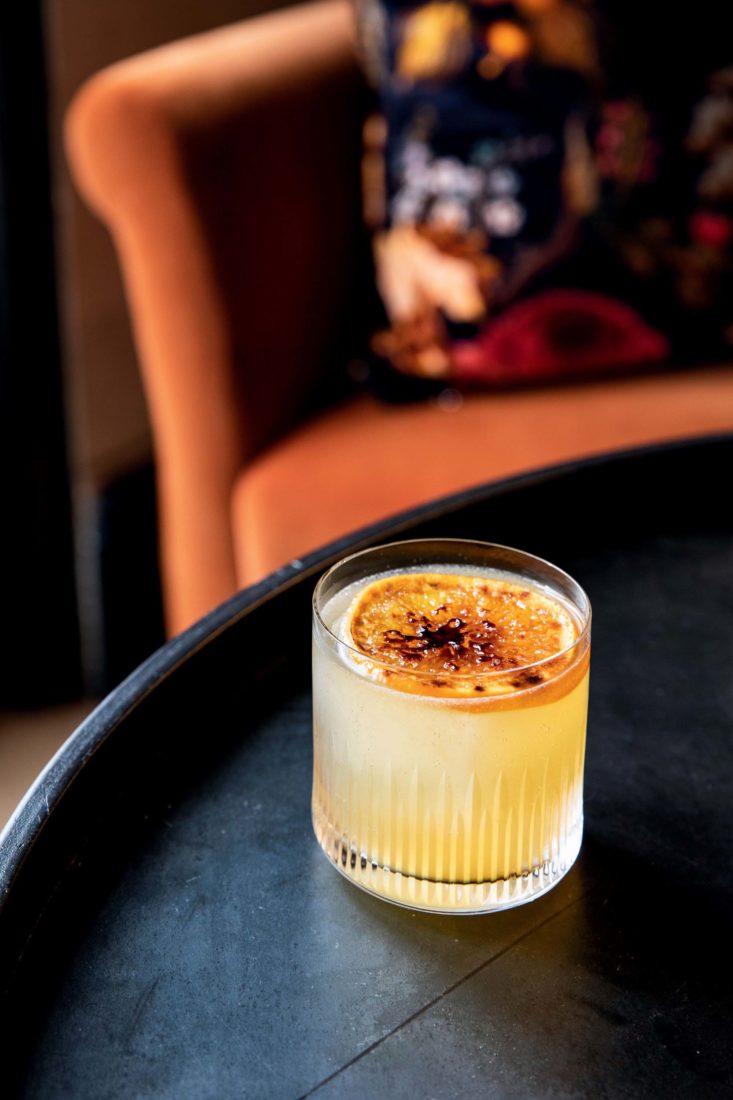From the lobby of the new Central Station Hotel in downtown Memphis, where travelers once waited for City of New Orleans trains, and where a beaded portrait of soul godfather Isaac Hayes now stands watch, my wife, Blair, and I descend the stairs to Eight & Sand. Above the hotel bar looms a green neon sign that once directed passengers to the lower-concourse tracks. Mounted on the wall like objets d’art are a reel-to-reel deck and a library of classic albums recorded by Memphis titans.
Dangled from ceiling pendants, a speaker array broadcasts a greasy playlist that sounds like it was lifted from Dolemite Is My Name. The drink list centers on shout-outs to the cities served by Amtrak, including New Orleans (Sazerac with brandy and rum) and Chicago (old-fashioned with Illinois-distilled Koval bourbon). Layer upon layer, the details add up to a chronicle of midcentury Memphis, a celebration of travel, and a reminder of what’s possible beneath the roof of a grand hotel.
The bar is a project by Andy Ticer and Michael Hudman, Memphis natives and childhood best friends. They also oversee the hotel’s room service—which delivers croque madames with shoestring fries and tidy chicken sandwiches swabbed with Calabrian honey—and its ground-floor restaurant, Bishop. Beginning with Andrew Michael Italian Kitchen, Ticer and Hudman have built a small empire of six restaurants here and in New Orleans. (Disclosure: They’re supporters of the Southern Foodways Alliance, which I direct.) Luxe and indulgent, Bishop is their most beautiful and aspirational yet.

Painted a color that might be green and might be blue and somehow evokes France in the years after World War II when so many Americans discovered the bistros of Lyon and Marseille, the restaurant is a kind of mood ring. At lunch, seated in one of the two-person black leather booths that face South Main Street, Blair says Bishop recalls a French railcar barreling north to Paris. Come evening, amid flashes of red and green neon from the neighboring bar Earnestine & Hazel’s and the nearby Arcade restaurant, I say it conjures a Saturday night in 1970s Memphis, captured by hometown hero photographer William Eggleston.
When Hog & Hominy, the second of Ticer and Hudman’s restaurants, burned in January during a renovation, the boys (as they are widely known) shifted experienced cooks and servers from there to here. That’s one way to explain how Bishop, which formally opened in February, already knows its mind. Another way is to watch suave Nick Talarico, operations manager for the restaurant group, walk the floor, offering advice to colleagues and chatting up regulars. Or listen to ebullient Ryan Radish, the group’s lead sommelier, as he talks up a chardonnay from the Jura that tastes of honeydew and hayloft and fresh-turned earth.
Inspired by French restaurants in Louisiana and France, the food is correct. The mushroom-layered center of a quiche jiggles like it should. Piled like cannonballs at a nineteenth-century fort, a pyramid of pommes dauphine looks goofy and tastes great. Order mussels steamed in a broth of Chablis and fennel and you get a sidecar of frites for dunking. For the grand aioli, the boys tuck endive leaves and soft-boiled egg halves and bundles of rare tenderloin around a bowl of garlic mayonnaise stirred with a buoyant lemon mousseline. Again, for dunking.
While Bishop presents like a French fantasy, the food inevitably gestures back to the South. A Lyonnaise salad reminds me of bacon-grease-dressed Appalachian killed lettuce. Escargot, drenched in garlic and parsley butter, gets crunch from a confetti toss of brunoised and fried chicken gizzards. (Think of the bits of skin and batter that fall to the bottom of a Popeyes bag and you get close.)
At Bishop, texture drives taste. For the salade maison, leaves of soft Bibb in a tomato and Dijon vinaigrette get a shower of panna grata, an Italian cheese-and-breadcrumb mix the boys also use liberally at their other restaurants. With a rib-eye cap, carved into thick slices, we order garnishes. The Mornay-creamed spinach benefits from a lid of pecorino frico, fried garlic, and more panna grata. Combined, those crunchy bits do the work Ritz crackers do in church-basement casserole cooking. The hits keep coming as we progress toward one-bite profiteroles, gorged with vanilla ice cream and drizzled with caramel and chocolate sauces. And a round of digestifs made with cognac and amaro and vermouth. Followed by a slow climb up those neon-washed stairs.

A generation ago, when Günter Seeger cooked at the Ritz-Carlton in Atlanta and Louis Osteen ruled at what is now Belmond Charleston Place in South Carolina, the best restaurants in the South did business in grand hotels. More recently, chef-owned restaurants, set in funky refurbished warehouses, have driven ideas about dining. Today, as those chefs face down new economic realities, more independents now cut deals with hotel groups and developers.
Bishop may be part of a trend. But Bishop is also a singular pleasure. Driving home, after spending a weekend in this new hotel in this old space, Blair and I talk of how our time at table transported us. In the way a great novel can, or travel to another country does, lunch or dinner here picked us up in one place and put us down in another. Having taken the trip, we are better for it.








